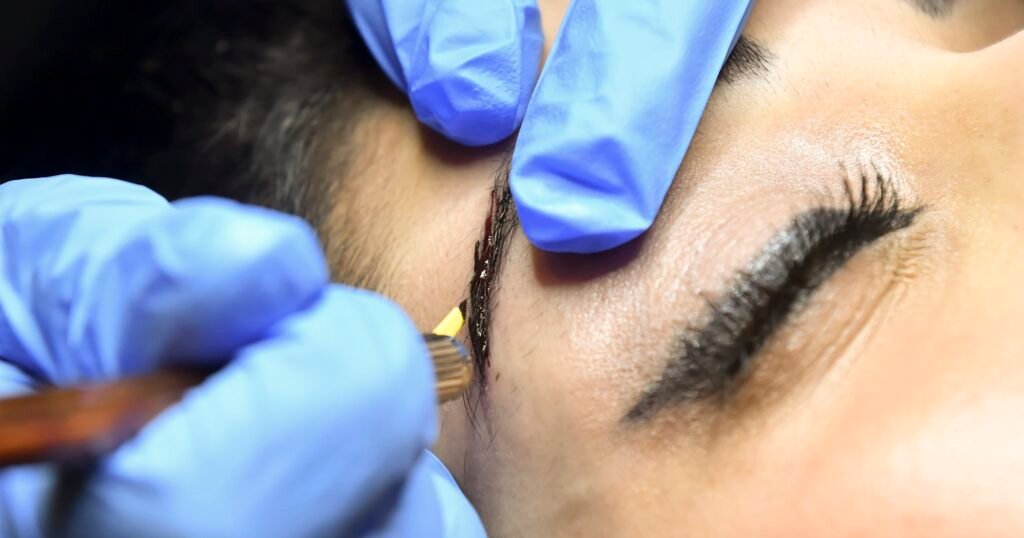Those of us who have our brows done every day know how troublesome it can be, especially when you can’t seem to get the shape right or use too much product and have to turn. Whether your brows are naturally super thin, lacking shape, or you’re still recovering from the thin brow trend of the ’90s and early 2000s, using a brow pencil, gel, or brow cream can help you achieve the brows of your dreams. However, the results were very short-lived. You may be wondering: What is microblading?
Microblading is a semi-permanent option for those who are eager to stop using brow products on a daily basis. Although it’s sometimes called an eyebrow tattoo, the results don’t last forever and the entire process isn’t too painful or time-consuming.
If you’ve been considering microblading or are interested in learning more, you’re in luck. We spoke with board-certified dermatologist Alexandra Bowles, MD, to learn about the duration of results, the overall process, and how long microblading takes to heal. Read on to get the scoop from the experts.
Experts featured in this article
Alexandra Bowles, MD, is a board-certified dermatologist living in Cincinnati. She is a member of the American Academy of Dermatology, Women’s Society of Dermatology, and the Florida Dermatological Society.
What is Microblading Eyebrows?
Eyebrow microblading is a cosmetic technique that deposits a tattoo-like color on the brows to help enhance and reshape them. When completed, the therapist will use small, fine-tipped needles to deposit pigment into the surface layer of the skin.
“Unlike traditional brow tattooing, which uses a machine, microblading is done by hand, which allows the practitioner to create fine, hair-like strokes that mimic the natural pattern of the brow,” Dr. Powers tells PS.
Is microblading permanent?
“It’s important to note that microblading is considered a semi-permanent procedure, which means the pigment will fade over time and may need to be refreshed with touch-ups to maintain the desired appearance,” says Dr. Powers , adding that grooming will depend on personal factors and personal preference.
Microblading brows also carries a certain level of risk. “Incorrect technique and poor quality pigments can leave a less than ideal color on the skin. I have seen this in some patients who have needed laser treatment to try to remove pigment, which is difficult to do in hair — Laser removal of bearing areas can also cause permanent hair loss,” she explains. “I remind all patients to ensure their microblading procedure is performed by experienced professionals using high-quality products.”
If not permanent, how long does microblading last?
Typically, microblading lasts one to three years. However, this may vary from person to person. “People with oily skin may find that their pigment fades more quickly than people with less oily skin,” says Dr. Powers. “To get the most out of your microblading treatment, it’s important to follow specific aftercare instructions.” This can include moisturizing properly and avoiding activities like swimming and excessive sweating—which can help pigments stay in place longer.
“Other factors that determine pigment longevity include your exposure to sunlight, your body’s own healing process after surgery, and the quality of the pigment,” she explains. “Using high-quality sunscreen, working with your doctor to determine if any modifications are needed, and finding a qualified doctor to perform the service are all major factors in extending the life of the service.”
How much does microblading cost?
The cost of microblading may depend on several factors, such as the city you live in, the practitioner’s experience, and more. On average, the surgery costs $500 to $1,000, Dr. Bowles said.
Does microblading hurt?
The level of pain associated with microblading varies from person to person, depending on the individual’s pain tolerance, the skill of the technician and the technique used. “In general, most people describe the feeling of microblading as uncomfortable rather than painful,” says Dr. Powers.
“In most cases, a local anesthetic will be used to help numb the area. You will most likely feel the pigment being deposited on the skin,” she adds. “Be sure to speak with your doctor if you experience any discomfort during the procedure. To ensure a more comfortable and positive microblading experience, it is important to choose a skilled and experienced technician who uses high-quality tools and techniques. ”
What is the microblading process?
Depending on which doctor you see, the process of microblading your brows may look different. However, in most cases, a consultation takes place before the actual procedure begins. This will include your ideal brow shape, the color of pigment, and the overall look you’re interested in.
“After the consultation, a local anesthetic will be applied to allow it to take full effect before starting,” says Dr. Powers. “At this point, your doctor will likely map out your brows and make sure your pigment matches the color of your brows, skin, and hair.”
The technician will then use a sterile hand-held tool with a fine-tipped needle to carefully draw and shape the brows according to the agreed-upon design. “This involves creating precise, hair-like strokes that mimic the brow’s natural growth pattern,” explains Dr. Powers. “The technician can also use a special pencil or marker to outline the shape and arch of the brow before starting the microblading treatment.”
Once your brows are drawn and shaped, the technician will use a handheld tool to deposit the selected pigment into the surface layer of the skin – creating fine, defined and natural-looking strokes. “Experienced technicians work carefully to fill in sparse areas, define shape, and enhance the overall appearance of the brows,” says Dr. Powers. “Throughout the microblading process, the technician will periodically apply more pigment to the brows, allowing it to penetrate into the skin and create long-lasting results.”
Your technician will also ensure that the pigment is evenly distributed and that the strokes blend seamlessly with your natural brows. Dr. Bowles explains that the entire treatment typically takes about two to three hours to complete, depending on the complexity of the design and the individual’s needs.
What is the microblading healing process like?
Since the procedure involves the use of small, thin needles, you may experience some swelling and redness immediately after the procedure, just like any other invasive procedure.
“You may even notice that over time, your skin adapts to the procedure and shows signs of scabbing, flaking, itching, darkening, or even discoloration,” says Dr. Powers. “This is part of the healing process, and over time your skin will adjust and the pigment will lighten as it settles. Then you should start to see the final results.”
If you have any concerns or questions, or if your skin doesn’t feel like it’s healing well, it’s best to contact your doctor.
Microblading post-operative care
As with all surgeries, post-operative care is a critical part of the process to ensure proper healing and long-lasting results. “General guidelines include keeping your brows clean and dry for 24-48 hours after surgery,” says Dr. Powers. “This includes keeping your brows dry so they can heal. Additionally, applying ointments will help keep your skin moisturized and protected.”
Similar to any procedure on the skin, you need to avoid overexposure to the sun – direct sunlight, tanning beds, etc. Dr. Powers recommends applying plenty of sunscreen and even covering the eye area for extra protection.
“Aftercare also includes not using makeup and skin care products for at least a week after surgery,” she explains. “Not doing this may interfere with the healing process. This is also a good time to be gentle with your skin, such as not rubbing your eyes or causing any additional irritation to the skin.”
Sydney Wingfield has been a freelance writer in the beauty and wellness fields for six years. She writes for Women’s Health, Marie Claire, Allure, and other publications and enjoys covering all things skin care, makeup, and hair.

